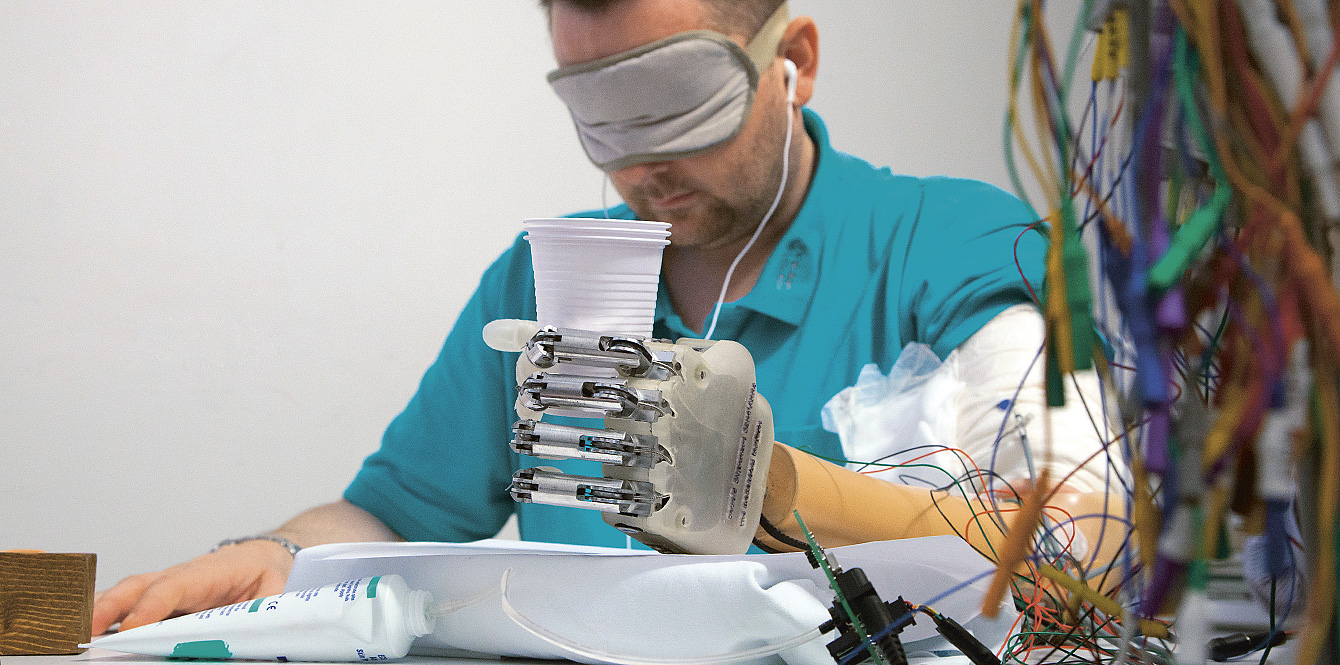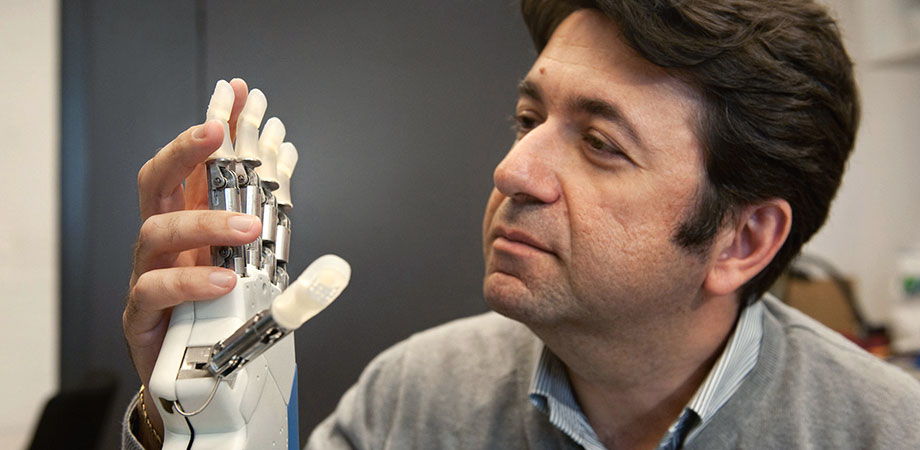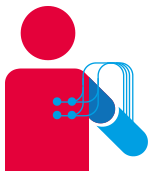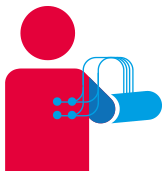
Quadriplegic and amputee patients are now able to control their artificial limbs. Neuroprostheses will one day help them regain their sense of touch.
Apr 07, 2015
Research on neuroprosthetics – artificial limbs that quadriplegics and amputees can control by thought – is advancing swiftly.
Johns Hopkins University in Baltimore made a landmark operation in December 2014. A man who had lost both arms was fitted with two bionic prosthetic limbs. The American amputee was able to control both robotic arms separately through nerve impulses. Meanwhile, researchers at the Swiss Federal Institute of Technology in Lausanne (EPFL) presented the e-Dura spinal implant, which is placed directly onto an injured spinal cord. Combining chemical and electrical stimulation, the device has already enabled paralysed rats to walk again.
Jul 16, 2014
Brain implants, which are mainly used by paralysis or amputee patients to control
neuroprosthetics by thought, may be able to stimulate the memory one day. A research agency of the Pentagon is working on a brain implant to restore the lost memory of wounded soldiers. Wake Forest University neurologist Robert Hamspon conducted an initial experiment in which he was able to introduce an image into the memory of a monkey that the animal had never seen before.
Collaboration in technological and surgical research has spawned prostheses that connect directly to the brain. These artificial limbs will revolutionise the lives of amputees and paralytics. “The devices function as extensions of the body,” says Wassim Raffoul, chief of the Plastic and Reconstructive Surgery Service at Lausanne University Hospital (CHUV). “They connect to the nervous system and reproduce movements that the patient thinks about. Prostheses controlled by muscle contraction existed already but, far from being intuitive, the learning curve for patients was too steep.”
In the United States, neuroprosthesis research focuses on quadriplegics. These patients have no electrical activity in the nerves that run through their limbs. So in order for them to control an artificial limb, it must connect directly to the source of the nerve impulses – the brain.
Brown University in the state of Rhode Island has developed a neural implant that enables completely paralysed patients to control a robotic arm with their mind. The implant is inserted in the motor cortex – the part of the brain that controls voluntary movement – where it senses the commands emitted when a person thinks of movement. These commands are then transmitted to a computer, where the information is decoded and sent to the artificial limb. Aclinical trial was conducted in 2012 by the United States Department of Veterans Affairs, the US National Institutes of Health, Brown University, Massachusetts General Hospital, Harvard Medical School and the German Aerospace Centre, which built the robotic arm. One woman, paralysed by a stroke, was able to pick up a thermos of coffee using the prototype.
“This is another big jump forward to control the movements of a robotic arm in three-dimensional space,” writes John Donoghue, director of the Brown University Institute for Brain Science, in the journal “Nature”. The scientists are now working to make the whole device less bulky and are developing a Wi-Fi system to eliminate the wires connecting the implant to the computer.
The Epione project involves several European universities and laboratories with the long-term goal to develop neuroprostheses for amputees. In 2014, the CHUV will begin conducting clinical trials in collaboration with the Swiss Federal Institute of Technology in Lausanne (EPFL). “The idea of the project is to develop artificial limbs allowing patients to regain their sense of touch,” says Wassim Raffoul.

Silvestro Micera runs the Neural Engineering Laboratory at the Swiss Federal Institute of Technology in Lausanne and is part of the Epione project. He achieved impressive results during different clinical trials conducted in Rome. A patient with an amputated forearm was able to control a robotic hand by thought and feel what he was touching. The researcher accomplished this feat by connecting electrodes implanted in the patient’s nerve fibres to an artificial hand. “We achieved excellent results in 2009,” says Silvestro Micera. “The patient regained his sense of touch, which greatly reduced his phantom pain. And as far as surgery goes, this operation is much simpler than a human hand transplant. We repeated the experiment on another patient in 2013. He was able to control his prosthesis in real time and had even more accurate sensations.” We are only five to ten years away from seeing the first complete, marketable neuroprostheses.
The devices function as extensions of the body. They connect to the nervous system and reproduce movements that the patient thinks about. Prostheses controlled by muscle contraction existed already but, far from being intuitive, the learning curve for patients was too steep.
Speaking of regaining sensory feeling, Stéphanie Lacour, head of the Neuroprosthetic Chair at the EPFL, is working on artificial micro-channels for reconnecting severed nerves. This type of injury can lead to loss of feeling and motor function in a limb, since the limb is no longer connected to the brain. “Until now, doctors have been using collagen tubes in which the nerve extremities partially reconnect,” says Stéphanie Lacour. “This procedure allows patients to regain only partial feeling and motor function, since the axons – minuscule fibres that make up the nerves – do not reconnect fast enough. The tubes that we have designed are smaller and will help the axons reconnect more easily.”
The researchers are also trying to understand what types of information circulate in the nerves. “We don’t yet know exactly where information on voluntary movement and sensory perception circulates inside the nerve,” says surgeon Wassim Raffoul. “You have to imagine the scale thatwe are working at: for instance, the sciatic nerve of a rat is 1.5 millimetres in diameter. Fortunately, we don’t have to reproduce the details of our anatomy perfectly to be able to connect neuroprostheses to the nervous system. By broadly capturing the electrical activity circulating in the nerves, we’re already achieving very good results.”
If all these research projects are successful, amputees can hope to receive an arm or leg that is extremely close to the original. “Our goal is to help these patients regain the best quality of life possible,” says Wassim Raffoul. “Neuroprostheses seem to be an excellent way to get there.
This series of diagrams illustrates one of the methods currently used to control a neuroprosthetic device.

1. Nerve endings remain active after amputation.

2. Nerves are redirected to another muscle through surgical procedure.

3. Once “reinnervated”, the muscle contracts when the patient thinks about moving their arm.

4. Electrodes sense the contraction and send the information to a computer located inside the prosthetic device.

5. The computer reads the control signals and activates limb movement.